Why I don't believe in Windows 8 on tablets

Sergey Makarenko
Before we start this tough conversation, it's worth saying that we're only talking about using Windows 8 with tablets. Microsoft is still preparing a version of Windows RT for ARM processors, which will require a complete rejection of Microsoft's sacred cow - support for apps built for Intel processors and using different instructions. If Windows 7 touch support was a frank compromise and spawned a whole class of useless and frankly useless tablets, then Windows 8 is another system by ideology where Microsoft has started to move in the direction of tablets and phones (meaning the unity of the code with Windows Phone 8, providing programmers "easy" porting for both platforms). Nevertheless, working version of Windows 8 RTM which won't differ from final version (no dramatic improvements will be available) seems to be the main operating system for desktops and laptops. And a complete failure (and nobody wants) for tablets.
Test Tablet
The test subject was a Samsung tablet that came out with Windows 7, with a version of Windows 8 RTM installed. This tablet has all the tools to turn it into a computer and make it relatively comfortable to use - a wireless keyboard, as well as a mouse, which can be connected thanks to the USB port (in which the radio module is installed). The tablet itself can be angled into a portable docking station, to which a power supply can be connected, as well as additional peripherals if needed. The only problem is that in this form, the system becomes less portable and overly cumbersome. That is, the idea of a tablet - one lightweight device capable of consuming content and typing not very large texts, is destroyed at the roots. Anyone who needs exactly a Windows system (by virtue of various reasons, which can be a million, and exactly one, the key to a particular person) would prefer such a solution to a simple laptop. Which, moreover will be either lighter, or cheaper, or more productive (as an option - will work longer). One of the most noteworthy features is the fan, required for Intel Core processor cooling, which is a drawback that ARM-based tablets (iPad and Android tablets) don't have. The system's capabilities and performance are as follows. Of course, the bottleneck of tablet performance is the graphics system. If you put a modern graphics card, you'll need more... that's right - extra fans. Interestingly, despite the interface previously known as Metro (and now, due to the claims of the supermarket chain Metro, called Windows UI, or simply - Windows UI), to see the characteristics of the system, you need to "fall" in the "normal" Windows - no other way (as we are used to see them, for example, in Android, just no). It should be noted that this "feature" of Windows 8 can be seen at Computex 2012, where the first devices on this version of the operating system were presented. As long as you run around the interface with tiles, everything is fine. As soon as you launch some application - well, there you go - it's "the same old, almost native" Windows.


At any moment by swiping from the right panel of the tablet you can see the "tablet" menu with settings - there is search, integration with social networks, list of connected devices and, actually, settings.
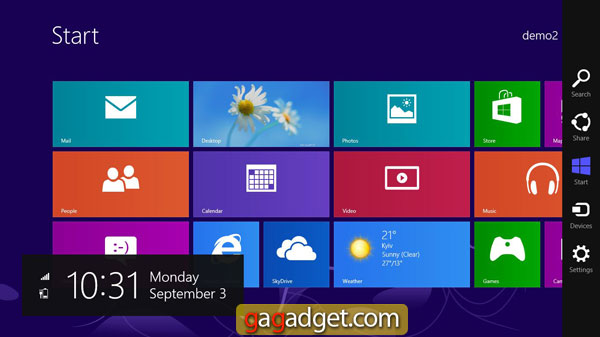
The list of settings adapted for working on the tablet (i.e. with your fingers, without a mouse and keyboard) is not long.

Here's most of the list. You can manage user accounts, Wi-Fi connections and so on. This seems to be pretty basic but we remember exactly how many settings you can do in Windows. For instance, trying to remove an installed application made me cringe. There is simply no "tablet" option to uninstall an app (or I couldn't find it). You have to go to the "old" Windows, open the app manager and play the old-fashioned "game" called "pixel hunt", trying to hit the right pixels on the screen with your finger.

There's some semblance of a "tablet" version of the Running App Manager, but there's no single way to invoke it, either, I've found. Of course, it is possible to press Ctrl + Shift + Escape on the keyboard, as I do on a laptop, but on a virtual keyboard there is simply no such possibility. You need an external keyboard for this operation. Which brings us back to the "but why?" question By the way, I took screenshots using the standard Print Screen key, but of course also with an external keyboard (comes in handy, fact, without it the tablet looks more like a pile of scrap metal - as it did with Windows 7 tablets).
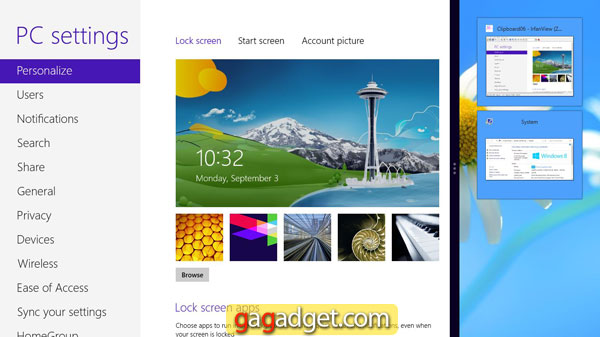
Speaking of the keyboard. It's exactly implemented "Microsoft-style" with a swagger. It's easy to add languages (even with fingers - special modules have been added), switch between them too.
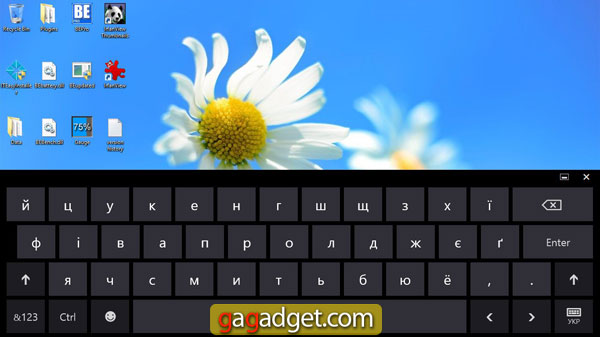
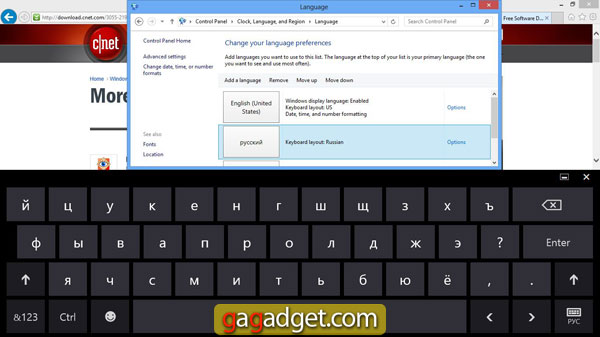
There is even a strange in every sense variant of ergonomic keyboard, theoretically intended for those who work with two hands, typing texts blindly. But the size of keys in this case is so small (more like on phone) that it's just impossible to work with two hands in such a shape. As a result we have an admiration and respectable but absolutely useless feature.
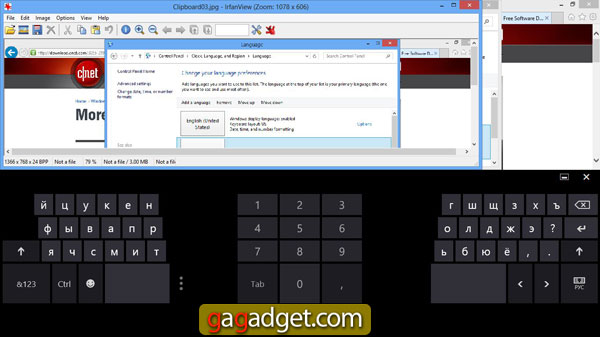
The list of installed applications can be called in this "telephone" style. I assure you - with the usual set of installed programs (for Windows it is dozens of units, including those pre-installed by Microsoft - here are all the service programs - Notepad, Scissors, which I use at work every day) it is very inconvenient to use such a list. Everything is too small.
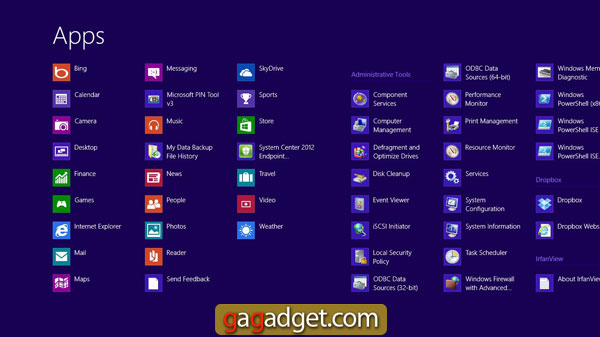
Shop. Great innovation, bringing the computer usage scenario closer to tablets and phones (or rather Apple computers). Lots of sections, most of which are currently filled with some useless nonsense.
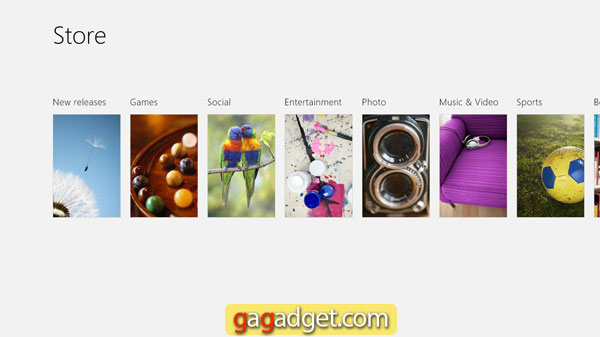
But it's so easy to update them. A trifle, but pleasant. It's done properly and in a human way. But unaccustomed if you'll be using Windows 8 on a laptop or desktop computer.
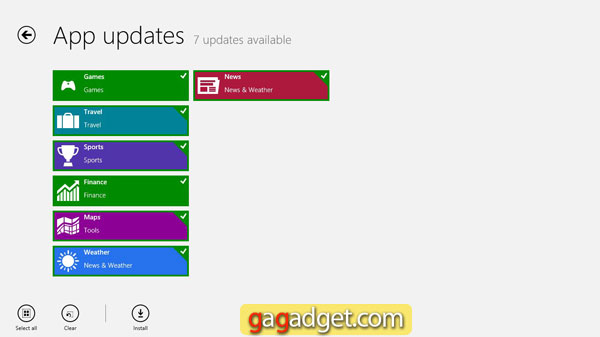
The Xbox games section looks characteristic. The Windows Phone situation looks like it will be repeated more than once or twice in our country. In many ways the new system is designed primarily for the US and secondarily for the rest of the civilized countries. And the last one - for third world countries, to which Ukraine certainly belongs according to table of ranks at Microsoft.
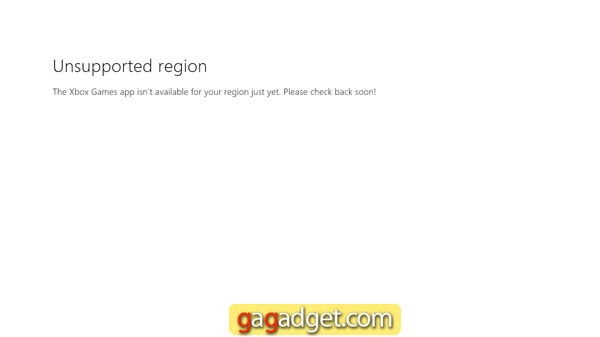
Office 2013
Pre-release version of Office 2013 is installed on the tablet. Microsoft promised that everything will be "correctly" adapted for tablets. When you run Word, all those illusions of promise dissipate like smoke. Yes, there is a File menu, which has tablet-friendly controls (for fingers). that's where all the tablet conveniences end and the same pixel-hunting begins.

The only tablet-adapted menu section is done right.
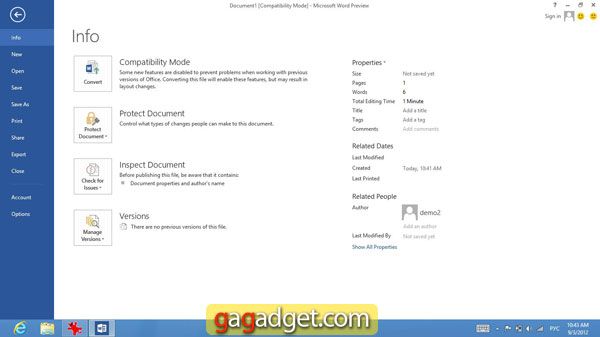
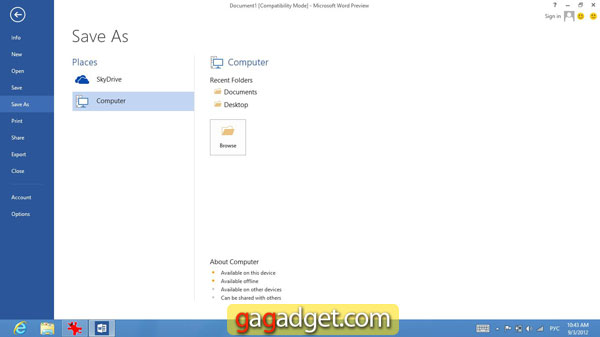
The rest are horror-horror. And it's a perfect illustration of why Windows 8 tablets won't be needed by anyone.
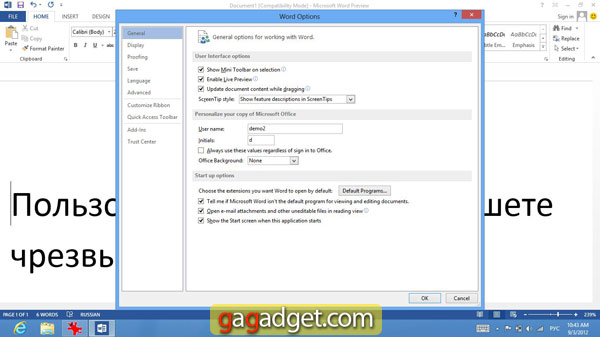
Instead of the conclusion
It's worth saying that Microsoft has been releasing tablets for 10 years, starting with the Windows XP Tablet Edition, of which I owned one myself in 2004. The idea looked interesting, but it took Apple, Jobs' genius or coincidence (underline the point) to realize one simple thing - tablets have to be closer to telephones than to computers by nature. It's a different use case (at the weight, in a café, outdoors, in transport), and a fundamentally different approach to the interface, and ARM processors showing significantly lower power consumption, giving the two main things - long runtime and no need for active cooling system (a side effect - tablets should be thinner and lighter). If Windows 7 for tablets looked like a compromise (transitional, if you will) and an attempt to "cram what we can't cram", then Windows 8 is the fruit of a strategic decision to gradually merge systems for computers with systems for phones and create our own ecosystem in the same way Apple did. There's really nothing wrong with copying Apple's idea from a business perspective. But Microsoft seems to have missed the point. Or didn't have the balls of steel to make the drastic decision to separate tablets and phones from computers and laptops. As a result, we're seeing dozens of devices announced in 2012, imposed by the Intel + Microsoft bundle on computer manufacturers. They feature touchscreens, but are meaningless to use. For all that, Windows 8 for PC looks like a natural evolution of the Windows operating system for desktops and laptops. Yes, the legendary Start button has disappeared, the absence of which we will get used to for a year, but we're still getting used to it. But a few ideologically correct things appeared - application store, integration with cloud services (in the first place, of course, mail, office suite and its own file storage SkyDrive). There's also no doubt that the right path for Windows tablets is Windows RT, designed for ARM processors. These tablets will be devoid of fans, rudiments (hopefully) in the form of support for legacy apps built for previous versions of Windows, and using an interface designed for finger-only use (without having to plug in a keyboard or, god forbid, a mouse every time). That's the Windows RT tablets I still believe in for now. Updated: It is quite rightly pointed out in the comments to the feature of switching the touch mode in MS Office that I did not notice (thanks to the developers for the user-friendly interface, by the way). Since there is no way to check everything, we leave the question for the final release and Windows 8 devices. If any manufacturer even dares to bring them in here.
Continued: Time Machine: Microsoft Surface tablet review
